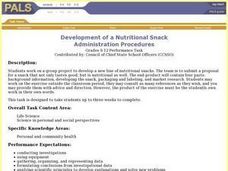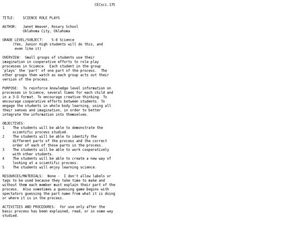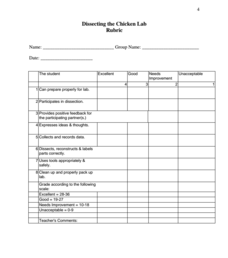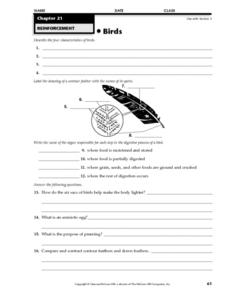Curated OER
Crayfish Dissection Worksheet
In this crayfish dissection worksheet, students answer 11 questions about crayfish bodies. One question requires students to label all the parts of a crayfish body.
Curated OER
Skeleton
First graders put a skeleton together and draw the main bones in the body. In this skeleton lesson plan, 1st graders learn about the main bones, and draw 8 out of 10 of them correctly.
Curated OER
Beef Is Good For You
Students discuss as a class the need for a healthy diet. They bring in a food product and analyze the nutrition label. Using the labels, they complete a worksheet and chart the nutrients found in beef. They use a scale to see how...
Curated OER
Friendly Letter Writing
Third graders write a friendly letter. In this writing lesson plan, 3rd graders consider audience, purpose, labeling, salutation, body, closing, and ending. Some excellent examples of friendly letters are shared with the students in a...
Curated OER
Let's Write Invitations for our Class Celebration
Students examine the parts of a letter and a written invitation. They write letters inviting family members to a classroom celebration.
Curated OER
Lesson Plan Three: Sense of Hearing and The Ear
Students use their sense of hearing to observe sounds at school, label parts of the ear, and write their own version of the "Ears Hear" poem by following the example provided.
Curated OER
Development of a Nutritional Snack
High schoolers develop a new line of nutritional snacks. They work in teams to submit a proposal for a snack that not only tastes good, but is nutritional as well. Their end-product consists of four parts: background information,...
Curated OER
Beautiful Bovine
Learners compare and contrast a human body to a cow. Using a diagram, they label and identify the functions of the cow's numerous parts. In groups, they create a Venn Diagram to compare the various types of cows with one another. They...
Curated OER
On the Microbe Trail: Bacteria and Aseptic Technique
Students pour, label, streak, seal and store plates in an incubator. They identify areas in their environment that provide a rich fauna of microbes once they have been swabbed. They identify areas of contamination through a laboratory...
Curated OER
Science Role Plays
Students use their imagination in cooperative efforts to role play processes in Science. Each student in the group 'plays' the 'part' of one part of the process. The other groups then watch as each group acts out their version of the...
Curated OER
Diet: Find the Carbohydrates
Students discover and discuss the functions of carbohydrates. Once they have taken notes and completed worksheets, they perform experiments using iodine to test for starch. Lesson topics include how carbohydrates are processed by the...
Curated OER
SCIENCE ROLE PLAYS
Students create a play in which each person in the group is a "character" or part of a system. In this creative instructional activity students are assigned a process in which they write a script about with characters.
Curated OER
Skeletal Structures
Students relate the location and the function of individual skeletal parts. Students identify and discuss skeletal differences between species. Students identify and define related terminology. Students individually complete a written...
Curated OER
Bird Activity
For this bird worksheet, students complete a set of 16 activities about birds, listing characteristics, matching organs with steps in the digestive process, labeling a drawing of a feather and completing 4 short answer questions.
Curated OER
Classroom Identity
Students explore fingerprints. In this finger prints lesson, students investigate how to classify fingerprints. Students study large pictures of fingerprints and circle the patterns they know how to identify. Students then take their own...
Curated OER
Down the Drain
Young scholars explore what problems might occur if oxygen decreases in a body of water. They model what happens in a situation where decomposition is occurring. Students obtain, organize, graph, and interpret information. They i...
Curated OER
Lobster Models
Students create and label a model of a lobster. In this lobster instructional activity, students become familiar with the parts of a lobster and their functions. Students display their lobsters in the classroom.
Curated OER
Micro-organisms
Students learn what a micro-organism is. In this micro-organism lesson, students understand that micro-organisms may be too small to see. Students learn microorganisms could be bacteria, fungi, something beneficial or a harmful microbe....
Curated OER
Scale Model of the Solar System
Young scholars work in groups of 4-6 for the experiment/activity part of this exercise. Students know that earth is the third planet from the sun in a system that includes the moon, the sun, eight other planets and their moons, and...
Curated OER
The Affects of Hormones on Human Development
Learners examine the types of changes they are experiencing during adolescence. As a class, they are introduced to the physical changes in men and women and discover the functions of various glands. In groups, they research the affect...
Curated OER
Paper Comet Model with a Deep Impact
Learners create paper comet models. They discuss facts about comets and build a model to determine the way the sun affects a comet. They create a comet and label the head and tail portions. They discuss their comet model and share it...
Curated OER
Life Processes and Living Things-Humans and Other Animals
For this fill in the blank worksheet, learners respond to 20 short answer questions by identifying foods that contain large amounts of sugar, carbohydrate, and fruit acids and explaining their effects on the body.
Curated OER
The Incredible, Edible Cell
Students discover organelles and the functions organelles perform in cells. For this biology lesson, students create model cells using Jell-o, then dissect their "cell" to examine the parts that create a cell. Students create a diagram...























